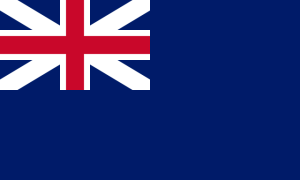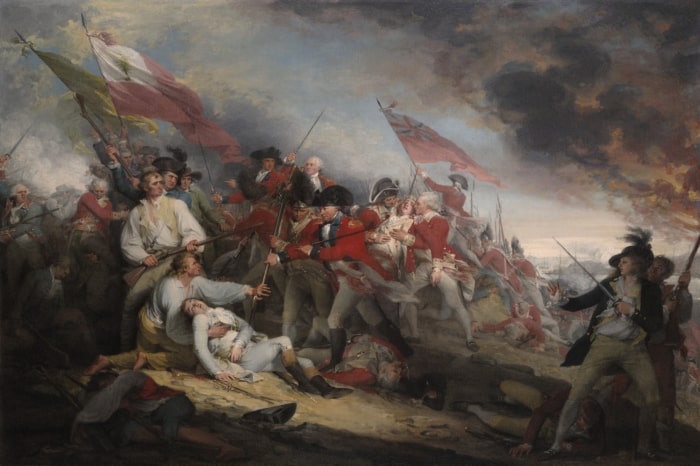
The Bunker Hill Flag, also known as the Blue Ensign of New England, is thought to have been flown by continental forces at the Battle of Bunker Hill, on June 17, 1775.
However, historians disagree about whether or not this flag actually featured in the Battle of Bunker Hill. And if the flag was used, there is also disagreement about what it looked like.
Despite these controversies, the Bunker Hill Flag remains a very popular symbol of the battle, and of colonial unity more broadly, to this day.
Design and origin
The flag is a version of the British Blue Ensign. It has a dark blue background, with a St. George’s Cross (the English flag) in the canton. Inside the top left corner of the cross is a green Pine tree, a symbol of New England.
The British Blue Ensign was used by Royal Navy ships in the 1700s, and featured the same design, except with the English flag rather than a Pine tree in the top left corner.

However, when England and Scotland united to form Great Britain in 1707, the Blue Ensign was updated to have the Union Flag, rather than the English flag, in the canton, in order to represent England and Scotland. This lends credence to the idea that the Bunker Hill Flag may not have existed, or may not have been described accurately in historical sources, as the canton design of the ensign it was based on is incorrect for the time.

The Pine tree in the corner of the flag was used as a symbol of the strength and independence of the colony of New England. Defacing the British Blue Ensign with this symbol was an act of defiance and a statement of rebellion against the crown.
Usage
The Bunker Hill Flag is said to have been used by American soldiers at the Battle of Bunker Hill, during the Siege of Boston.
It would have been used to help keep troops organized into their different militias on the battlefield, and to organize forces’ movements before going into fight.
However, most eyewitness accounts of the battle recall that no flags were used by colonial soldiers.
This is disputed by John Trumbull, an American artist who witnessed the battle from afar, and painted The Death of General Warren at the Battle of Bunker’s Hill, June 17, 1775 a decade later.
He depicts the usage of the Continental Flag (second from left) by American forces at the battle. However, his painting also shows another flag that did not yet exist in June 1775, leading many historians to question the historical accuracy of his work.
It is thought that our current source for the design of the New England Blue Ensign, a book published in the 1800s, mixed up the background color of the flag. Supposedly, the flag was originally red, which would make more sense, because this would have made it match the color of the English Red Ensign.
The Red Ensign was used on merchant ships, meaning there would have been more copies of it in the colonies, compared to the blue version used in the Royal Navy. Also, merchant ships would have been less likely to immediately update their flags to the British (not English) Red Ensign when the United Kingdom came to be in 1707.
Also, the English Red Ensign defaced with a Pine tree is known to have been used by colonists during the war, unlike the Bunker Hill Flag.
Historical significance
This flag stands today as an enduring symbol of the Battle of Bunker Hill, even though it might not have been used during the battle, or it might have looked completely different from how we know it today.
At Bunker Hill, although they lost the battle, American forces inflicted heavy losses on the British, and demonstrated that their ragtag militias could put up a real fight against a much stronger opposition on paper. The Bunker Hill Flag came to be associated with this determination, and colonial unity.
The Bunker Hill Flag featured on a US postage stamp in 1968. A modified version with six stars in a circle to represent the six states of New England was adopted by the New England Governor’s Conference in 1998, although the region does not have an official flag to this day.



